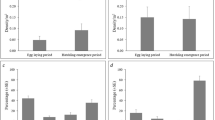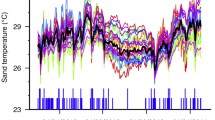Abstract
In marine turtles, the sex of an individual is determined by temperatures experienced during embryonic development. Gonad histological observation is still the only reliable way to determine hatchling sex, hampering the study of reproduction and of the demographic consequences of context-dependent sex-ratios, a subject of interest in a warming planet. We investigated whether hatchling remains from predation by Ocypode cursor can be used to estimate sex-ratio trends in a green turtle rookery at Poilão, Guinea-Bissau (10°52′N, 15°43′W). Sex could be readily determined in 77 and 79% of the predated hatchlings in 2008 and 2009, respectively. By comparing hatchlings killed by crabs, hatchlings accidentally dying on the reefs, and live hatchlings, we show that ghost crabs select the smaller prey, but do not select according to hatchling sex, which is explained by the lack of hatchling size dimorphism in this population. The proportion of male hatchlings was 0.45 ± 0.06 and 0.15 ± 0.06 for early and late-season clutches, respectively, these differences most likely being explained by rainfall. Using leftovers from predation by crabs may be a good solution to non-invasively monitor broad trends in sex-ratios of sea turtles.



Similar content being viewed by others
References
Ali A, Ibrahim K (2002) Crab predation on green turtle (Chelonia mydas) eggs incubated on a natural beach and in turtle hatcheries. Proceedings of the 3rd workshop on SEASTAR2000, Graduate School of Informatics, Kyoto University, pp 95–100
Bell MA, Lamb PJ (2006) Integration of weather system variability to multidecadal regional climate change: the West African Sudan-Sahel zone, 1951–98. J Climate 20:5343–5365. doi:10.1175/JCLI4020.1
Bolten AB (1999) Techniques for measuring sea turtles. In: Eckert KL, Bjorndal KA, Abreu-Grobois FA Donnelly M (eds) Research and management techniques for the conservation of sea turtles. IUCN/SSC Marine Turtle Specialist Group Publication 4, Blanchard, pp 110–115
Booth DT, Burgess E, McCosker J, Lanyon JM (2004) The influence of incubation temperatures on post-hatching fitness characteristics of turtles. Int Congr Ser 1275:226–233
Broderick AC, Godley BJ, Reece S, Downie JR (2000) Incubation periods and sex ratios of green turtles: highly female biased hatchling production in the eastern Mediterranean. Mar Ecol-Prog Ser 202:273–281. doi:10.3354/meps202273
Burgess EA, Booth DT, Lanyon JM (2006) Swimming performance of hatchling green turtles is affected by incubation temperature. Coral Reefs 25:341–349. doi:10.1007/s00338-006-0116-7
Catry P, Barbosa C, Indjai B, Almeida A, Godley BJ, Vié J (2002) First census of the green turtle at Poilão, Bijagós Archipelago, Guinea-Bissau: the most important nesting colony on the Atlantic coast of Africa. Oryx 36:400–403. doi:10.1017/S0030605302000765
Catry P, Barbosa C, Paris B, Indjai B, Almeida A, Limoges B, Silva C, Pereira H (2009) Status, ecology and conservation of sea turtles in Guinea-Bissau. Chelonian Conserv Biol 8:150–160. doi:10.2744/CCB-0772.1
Catry P, Barbosa C, Indjai B (2010) Marine turtles of Guinea-Bissau. Status, biology and conservation. Instituto da Biodiversidade e das Áreas Protegidas, Bissau
Ceriani SA, Wyneken J (2008) Comparative morphology and sex identification of the reproductive system in formalin-preserved sea turtle specimens. Zoology 111:179–187. doi:10.1016/j.zool.2007.07.007
Chaloupka M, Kamezaki N, Limpus C (2008) Is climate change affecting the population dynamics of the endangered Pacific loggerhead sea turtle? J Exp Mar Biol Ecol 356:136–143. doi:10.1016/j.jembe.2007.12.009
Delgado C (2008) Gonad development and hormone titres in loggerhead sae tutles (Caretta caretta) in the NE Atlantic. Dissertation, Universidade da Madeira, Funchal
Ewert MA, Nelson CE (1991) Sex determination in turtles: diverse patterns and some possible adaptive values. Copeia 1991:50–69
Fortes O, Pires AJ, Bellini C (1998) Green turtle, Chelonia mydas, in the island of Poilão, Boloma-Bijagós Archipelago, Guinea-Bissau, West Africa. Marine Turt Newsl 80:8–10
Glen F, Mrosovsky N (2004) Antigua revisited: the impact of climate change on sand and nest temperatures at a hawksbill turtle (Eretmochelys imbricata) nesting beach. Glob Change Biol 10:2036–2045. doi:10.1111/j.1529-8817.2003.00865.x
Glen F, Broderick AC, Godley BJ, Hays GC (2003) Incubation environment affects phenotype of naturally incubated green turtle hatchlings. J Mar Biol Assoc UK 83:1183–1186. doi:10.1017/S0025315403008464h
Glen F, Broderick AC, Godley BJ, Hays GC (2005) Patterns in the emergence of green (Chelonia mydas) and loggerhead (Caretta caretta) turtle hatchlings from their nests. Mar Biol 146:1039–1049. doi:10.1007/s00227-004-1492-6
Glen F, Broderick AC, Godley BJ, Hays GC (2006) Thermal control of hatchling emergence patterns in marine turtles. J Exp Mar Biol Ecol 334:31–42. doi:10.1016/j.jembe.2006.01.005
Godfrey MH, Barreto R, Mrosovsky N (1996) Estimating past and present sex ratios of sea turtles in Suriname. Can J Zool 74:267–277. doi:10.1139/z96-033
Godley BJ (2009) Incorporating climate change into endangered species conservation: Introduction. Endanger Species Res 7:85–86. doi:10.3354/esr00203
Godley BJ, Broderick AC, Glen F, Hays GC (2002) Temperature-dependent sex determination of Ascension Island green turtles. Mar Ecol-Prog Ser 226:115–124. doi:10.3354/meps226115
Gross TS, Crain DA, Bjorndal KA, Bolten AB, Carthy RR (1995) Identification of sex in hatchling loggerhead turtles (Caretta caretta) by analysis of steroid concentrations in chorioallantoic/amniotic fluid. Gen Comp Endocr 99:204–210. doi:10.1006/gcen.1995.1103
Gyuris E (1994) The rate of predation by fishes on hatchlings of the green turtle (Chelonia mydas). Coral Reefs 13:137–144. doi:10.1007/BF00301189
Houghton JD, Myers AE, Lloyd C, King RS, Isaacs C, Hays GC (2007) Protracted rainfall decreases temperature within leatherback turtle (Dermochelys coriacea) clutches in Grenada, West Indies: ecological implication for a species displaying temperature dependent sex determination. J Exp Mar Biol Ecol 345:71–77. doi:10.1016/j.jembe.2007.02.001
Ischer T, Ireland K, Booth DT (2009) Locomotion performance of green turtle hatchlings from the Heron Island Rookery, Great Barrier Reef. Mar Biol 156:1399–1409. doi:10.1007/s00227-009-1180-7
Janzen FJ (1993) An experimental analysis of natural selection on body size of hatchling turtles. Ecology 74:332–341. doi:10.2307/1939296
Kamel SJ, Mrosovsky N (2006) Deforestation: risk of sex ratio distortion in hawksbill sea turtle. Ecol Appl 16:923–931. doi:10.1890/1051-0761(2006)016[0923:DROSRD]2.0.CO;2
Kaska Y, Ilgaz Ç, Özdemir A, Baskale E, Türkozan O, Baran I, Stachowitsch M (2006) Sex ratio estimations of loggerhead sea turtle hatchlings by histological examination and nest temperatures at Fethiyes beach, Turkey. Naturwissenschaften 93:338–343. doi:10.1007/s00114-006-0110-5
Mendonça VM, Saady SA, Kiyumi AA, Erzini K (2010) Interactions between Green Turtles (Chelonia mydas) and Foxes (Vulpes vulpes arabica, V. rueppellii sabaea, and V. cana) on turtle nesting grounds in the Northwestern Indian Ocean: impacts of the fox community on the behavior of nesting sea turtles at the Ras Al Hadd turtle reserve, Oman. Zool Stud 49:437–452
Merchant-Larios H, Ruiz-Ramirez S, Moreno-Mendoza N, Marmolejo-Valencia A (1997) Correlation among thermosensitive period, estradiol response, and gonad differentiation in the sea turtle Lepidochelys olivacea. Gen Comp Endocr 107:373–385. doi:10.1006/gcen.1997.6946
Miller JD, Limpus CJ (2003) Ontogeny of marine turtle gonads. In: Lutz PL, Musick JA, Wyneken J (eds) The biology of sea turtles. CRC Press, Boca Raton, pp 199–224
Mrosovsky N, Benabib M (1990) An assessment of two methods of sexing hatchling sea turtles. Copeia 1990:589–591
Mrosovsky N, Bapistotte C, Godfrey H (1999) Validation of incubation duration as an index of the sex ratio of hatchling sea turtles. Can J Zool 77:831–835. doi:10.1139/z99-039
Myers EM, Tucker JK, Chandler CH (2007) Experimental analysis of body size and shape during critical life-history events of hatchling slider turtles, Trachemys scripta elegans. Funct Ecol 21:1106–1114. doi:10.1111/j.1365-2435.2007.01337.x
Pike DA (2008) Environmental correlates of nesting in loggerhead turtles, Caretta caretta. Anim Behav 76:603–610. doi:10.1016/j.anbehav.2008.04.010
Pinheiro J, Bates D, DebRoy S, Sarkar D, R Core team (2009) nlme: Linear and Nonlinear Mixed Effects Models. R package version 3.1-96. http://CRAN.R-project.org/package=nlme
Pintus KJ, Godley BJ, McGowan A, Broderick AC (2009) Impact of clutch relocation on green turtlte offspring. J Wildl Manage 73:1151–1157. doi:10.2193/2008-103
R Development Core Team (2010) R: a language and environment for statistical computing. R Foundation for Statistical Computing, Vienna
Reece S, Broderick A, Godley B, West S (2002) The effects of incubation environment, sex and pedigree on the hatchling phenotype in a natural population of loggerhead turtles. Evol Ecol Res 4:737–748
Stocker L (2005) Practical wildlife care, 2nd edn. Blackwell, Oxford
Toland B (1991) Great horned owl predation of Atlantic loggerhead turtle hatchlings. Fla Field Nat 19:117–119
Tomillo P, Paladino F, Suss J, Spotila J (2010) Predation of leatherback turtle hatchlings during the crawl to the water. Chelonian Conserv Biol 9:18–25. doi:10.2744/CCB-0789.1
Tureli C, Duysak O, Akamca E, Kiyagi V (2009) Spatial distribution and activity pattern of the ghost crab, Ocypode cursor (L., 1758) in Yumurtalik Bay, North-Eastern Mediterranean-Turkey. J Anim Vet Adv 8:165–171
Varo-Cruz N (2010) Biología reproductora de la tortuga boba (Caretta caretta Linneus, 1758) en la isla de Boavista, archipiélago de Cabo Verde. Dissertation, Universidad de Las Palmas de Gran Canaria
Wibbels T (2003) Critical approaches to sex determination in sea turtles. In: Lutz PL, Musick JA, Wyneken J (eds) The biology of sea turtles. CRC Press, Boca Raton, pp 103–134
Wibbels T, Owens DW, Limpus CJ (2000) Sexing juvenile sea turtles: is there an accurate and practical method? Chelonian Conserv Biol 3:756–761
Witt M, Hawkes L, Godfrey M, Godley B, Broderick A (2010) Predicting the impacts of climate change on a globally distributed species: the case of the loggerhead turtle. J Exp Biol 213:901–911. doi:10.1242/jeb.038133
Wyneken J, Epperly SP, Crowder LB, Vaughan J, Esper KB (2007) Determining sex in posthatchling loggerhead sea turtles using multiple gonadal and accessory duct characteristics. Herpetologica 63:19–30. doi:10.1655/0018-0831(2007)63[19:DSIPLS]2.0.CO;2
Zbinden JA, Christina D, Margaritoulis D, Arlettaz R (2007) Large spatial variation and female bias in the estimated sex ratio of loggerhead sea turtle hatclings of a Mediterranean rookery. Endanger Species Res 3:305–312. doi:10.3354/esr00058
Acknowledgments
Our work on sea turtle sex-ratios on Poilão is supported by Project 09/74 of MAVA—Fondation pour la Nature, by Project 77340-000 of IUCN—International Union for Nature Conservation and by FCT—Fundação para a Ciência e a Tecnologia (Portugal) through Programa Plurianual (UI&D 331/94). We also thank the support by the “Fondation Internationale du Banc d’Arguin” (FIBA). Permits were issued by IBAP—Instituto para a Biodiversidade e Áreas Protegidas of Guiné-Bissau. Authorization for euthanization of a sample of hatchlings in 2009 was obtained from the IBAP and the João Vieira and Poilão Marine National Park Direction. P. Segurado draw Fig. 1a. We thank the comments of two reviewers and are grateful to Thierry Renaud and Mathieu Ducroq for support and encouragement, for the support of the National Park staff João Pereira, Santinho, Rofico, António Baca, César Banca, and especially of the IBAP Director, Alfredo Simão da Silva.
Author information
Authors and Affiliations
Corresponding author
Additional information
Communicated by R. Lewison.
Rights and permissions
About this article
Cite this article
Rebelo, R., Barbosa, C., Granadeiro, J.P. et al. Can leftovers from predators be reliably used to monitor marine turtle hatchling sex-ratios? The implications of prey selection by ghost crabs. Mar Biol 159, 613–620 (2012). https://doi.org/10.1007/s00227-011-1839-8
Received:
Accepted:
Published:
Issue Date:
DOI: https://doi.org/10.1007/s00227-011-1839-8




